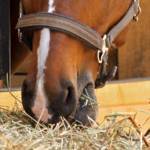Feeding the Mare after Weaning

Much emphasis is placed on the foals during the weaning process, and little attention is often paid to the mares. While it is true that mares, particularly those that have had previous foals, tend to weather weaning more calmly than their foals, nutritional changes in mares should not be forgotten.
In an effort to slow milk production, some horsemen stop feeding mares grain five to seven days before weaning and keep them off until their udders have dried up. The consumption of high-quality forages is reduced to that typically consumed by nonlactating mares. Decreasing milk production as quickly as possible will keep mares more comfortable. Although it may be tempting, do not milk out mares, as this will only provoke further milk production.
If a mare is in adequate body condition following weaning, she can be turned out on good quality pasture and managed similarly to barren or early pregnant mares. If lactation has reduced the body condition of the mare to the point where she is thin, grain and high-quality forage can be fed to facilitate weight gain, after the drying up period. As pregnancy advances, the requirements for trace minerals increase, so a low-calorie supplement such as a balancer pellet will be useful for the mare from mid pregnancy onwards.
Attention should be given to the careful management of mares following the weaning of their foals, especially if they are pregnant. Getting or keeping mares in optimal body condition may increase future reproduction efficiency.








